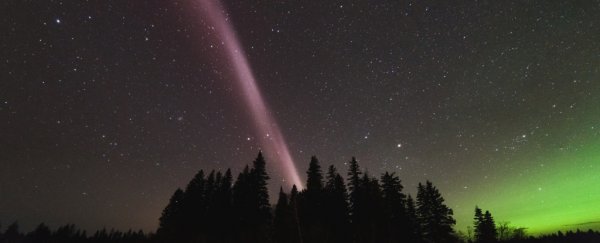Well, well, well. Looks like the jig is up. The "new kind of aurora" discovered earlier this year, and subsequently named "STEVE" (if that is even its real name) has been rumbled. It seems Steve isn't an aurora after all.
But that doesn't mean the game is over. Because Steve's actual identity may be even more interesting. Physicists have concluded that the erstwhile aurora is in fact an entirely new celestial phenomenon.
Steve - which manifests as gorgeous glowing purple ribbons across the sky - has been around for a few decades now, known to photographers and aurora chasers, but was only brought to the attention of scientists in 2016.
It had been nicknamed Steve by the Alberta Aurora Chasers, which scientists upheld when they officially named it Strong Thermal Emission Velocity Enhancement (STEVE).
Earlier this year, researchers announced that the purple and white streamers, while very different from the shimmering green auroral curtains, were indeed a new kind of aurora.
But the light produced by Steve isn't the same as the light produced by an aurora, so a new team of researchers worked on figuring out Steve's mechanism by studying a Steve event from March 2008.
An aurora is generated by solar winds, which interact with charged particles in our magnetosphere, mainly protons and electrons.
These charged particles rain into the ionosphere and travel along the planet's magnetic field lines to the poles, where they manifest as dancing lights in the sky, usually green, but sometimes red or blue, producing strong radio emissions.
This is not what is happening with Steve.
"Our main conclusion is that STEVE is not an aurora," said physicist Bea Gallardo-Lacourt of the University of Calgary in Canada.
To figure this out, the research team focused on the rain of charged particles in the ionosphere. They wanted to see if such a rain was occurring during a Steve event.
Such an event occurred on 28 March 2008, and data was obtained both by ground-based cameras that record auroras, and the NOAA's Polar Orbiting Environmental Satellite 17, which was directly overhead at the time, and which carries an instrument that can measure charged particles raining into the ionosphere.
This instrument detected no such particles. This means the mechanism that produces Steve must be different from the mechanism that produces auroras.
"Right now, we know very little about it," Gallardo-Lacourt said. "And that's the cool thing, because this has been known by photographers for decades. But for the scientists, it's completely unknown."
For now, the researchers have named the new optical phenomenon "skyglow" (don't worry, it's also still Steve for now). And they have plans to learn more.
The next step in their mission to unmask the true Steve is to try and determine if streams of fast ions and hot electrons in the ionosphere are responsible for Steve, or if its source is occurring at a higher altitude.
The research has been published in the journal Geophysical Research Letters.
